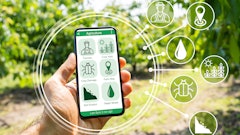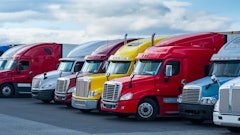
The influx in cargo theft, cybersecurity concerns and ever-changing industry regulations continue to threaten the safety and security of tomorrow’s supply chains.
But, when it comes to the State of the Supply Chain, the implementation of technology mixed with the ability to be flexible, nimble and versatile will enable the logistics world to pivot accordingly.
Marina Mayer, editor-in-chief of Food Logistics and Supply & Demand Chain Executive, talks exclusively with Erica Bressner, business intelligence analyst, BSI, and Jason Willoughby, business intelligence analyst, BSI, about how inflation, AI, increasing regulations and geopolitical tensions impact the future of supply chain.
CLICK HERE to read the article in full.
Food Logistics: Describe some of the challenges impacting many of today’s supply chains.
Erica Bressner: There are a number of major trends with the potential to affect supply chains as we head into 2024, many of which are continuations of those we identified at the start of the year in our Supply Chain Risk Insights Report 2023. In that report, our data showed that food and beverage products were the most stolen products in 2022 –17% of all products reported stolen, almost double the next highest commodities (agriculture, 9%, and electronics, 9%). Ongoing BSI analysis shows that trend has continued in 2023 with, as of the second quarter, food and beverage is being stolen at a rate of just over 2:1 of the next most stolen product. A major contributing factor in the high levels of food and beverage being stolen was inflation, which was at about 9% in 2022 compared to wage growth of only about 5%.
Areas for 2024 that are worth monitoring include:
1. Changing climate conditions
Adverse weather events can lead to freight delays and incomplete shipments, for example, the California drought and its impact on tomatoes. Such events can greatly impact the food industry due to the perishable nature of products in a living supply chain. For example, climate change is diminishing wheat crop yields, particularly in the world’s largest wheat-producing country, China. This is causing a decline in the global supply of flour and price increases in staple products, such as bread and pasta, across Europe. Another startling statistic is that NASA predicts that by 2030, maize crop yields will decline by 24%.
As changing climate conditions shift areas of arable land and farmers battle increasingly severe natural disasters, organizations can prepare by incorporating forward planning. Organizations can also develop and implement a supply chain resilience plan to identify critical suppliers and ensure continuity of supply in the event of a disruption.
2. Impacts of inflation
Though global inflation has begun to subside in many parts of the world predictions, suggest that prices for food products will hold relatively steady in 2024.
As such, based on last year’s data, we should monitor for the continued targeting of food and beverage products for thefts at higher-than-average rates. Though basic goods, namely, food and beverage, typically represent the top product type stolen, last year we also tracked an increase in thefts of food and beverage amid increasing inflation rates. This follows a common pattern in which products with increased demand and heightened value face additional theft risks. We expect that this trend will continue into 2024 and beyond, especially if adverse climate conditions result in price hikes and shortages of staple foods.
3. Increasing regulation
New regulations are likely to shape food and beverage supply chains, especially as they relate to environmental, social, and governance (ESG) reporting in the European Union (EU). However, the requirements entailed by these requirements will also shape the agricultural and food industries in other countries, especially those in South America, as export markets work towards compliance. Namely, these regulations include the Regulation on Deforestation-free products, the Proposal for a ban on goods made using forced labor, and the Directive on Green Claims. In addition, farmers have raised concerns about EU regulations aimed at reducing the usage of certain chemicals and pesticides deemed dangerous to bee populations for their potential impact on farmers globally and their ability to sell their products in the EU. In 2024, there is the potential for us to see continued tension between what might be good for the environment and the interests of farmers in some countries.
Looking ahead, organizations can prepare by seeking to address the root causes of issues addressed by these regulations in their supply chains. As we stated in the 2023 report: “Those organizations seeking to move from survive to thrive mode need to be not only abreast of these changes but ahead of them. Getting your supply chain prepared for new regulations means more time to plan and more time to implement new processes.” This sentiment still holds true – a thorough understanding of global regulations and their potential impact on the supply chain is essential.
4. Geopolitical tensions
Ongoing geopolitical tensions relating to the war in Ukraine are also likely to continue to impact agricultural policy into 2024. Historically, Ukraine supplied a significant portion of the world’s grains, especially to countries in the Middle East and Africa. Disruptions to these supplies have resulted in sharp price increases, furthering adverse economic conditions and deepening instability.
5. Technology and AI
We can expect new technologies such as AI and machine learning to continue to have an impact, especially as these relate to the ability to map the supply chain and predict future disruptions.
During the pandemic, technology was rapidly deployed out of necessity to meet demand and protect the supply chain, with data suggesting that 92% of firms did not halt technology investments at that time. A 2021 study from McKinsey calculates that AI-enabled supply-chain management has enabled adopters to improve logistics costs by 15%, inventory levels by 35%, and service levels by 65%.
Since then, we have seen significant investment in the use of technologies such as machine learning, blockchain and AI to help map the global supply chain. These technologies offer the chance for organizations to have more insight into the global movement of products than ever before.
AI, in particular, has been a hot topic almost universally in 2023. Within the food supply chain specifically, there is a tremendous amount of data that can be more thoroughly analyzed and used to predict potential disruptions to help mitigate the impacts on global populations. For instance, AI could be applied to cases of food fraud, which is estimated to cost the global food sector €30 billion annually. In these situations, by replacing the moment where people’s behavior could be compromised with an algorithm that can identify anomalies, research has identified that AI offers the opportunity to detect food fraud and prevent its recurrence.
AI has great potential to be a force for good, making supply chains more robust and efficient – but of course, there is a role for building trust too. BSI’s Trust in AI poll of 10,000 people around the world found that 77% of people said complete or at least some level of trust is needed for AI to be used to enable ethical supply chain management.
These trends can be seen not just through the lens of challenges, though, but as opportunities and new solutions for the supply chain.
Food Logistics: Describe the State of Sustainability, and what’s in store for supply chains come 2024 with certain ESG regulations coming down the pipeline.
Jason Willoughby: With ESG regulations up 155% globally, regulation overall will continue to shape supply chains in the coming year. Within the EU, companies should not only be aware of the regulations mentioned above but also the potential Corporate Social Responsibility Due Diligence Directive and the “European Green Deal,” which obligates non-financial disclosures aligned with the Task Force on Climate-Related Disclosures reporting standards.
Elsewhere, other laws and guidelines already exist to prevent companies from making false or misleading environmental claims. For instance, in the U.S., regulatory bodies such as the Federal Trade Commission (FTC) and the Environmental Protection Agency (EPA) have Green Guides, which were first issued in 1992 and are updated periodically, to help marketers avoid making unsubstantiated environmental claims that mislead consumers. Compliance with these types of regulations can be crucial to bridging the trust gap and ensuring consumers have accurate information about the products they purchase.
As we said in our 2023 report, there is a way through for organizations if they proactively manage and anticipate risks. Organizations can position themselves as thriving leaders by promoting human rights and ensuring that responsibility and sustainability are part of a company’s mission.
CLICK HERE to read the article in full.



























